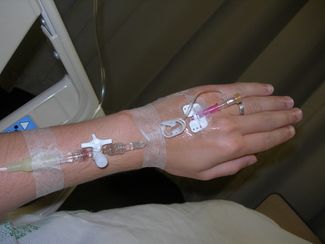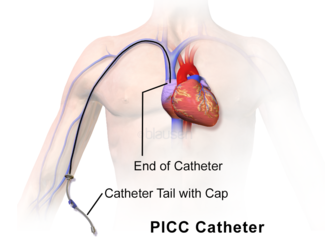Intravenous Lines: Difference between revisions
No edit summary |
No edit summary |
||
| Line 46: | Line 46: | ||
== Complications <ref name=":1" /> == | == Complications <ref name=":1" /> == | ||
{| class="wikitable" | {| class="wikitable" | ||
|Phlebitis | |||
| - inflammation of the vein's inner lining (tunica intima) | |||
- localized redness, pain, heat, and swelling which can track up the vein leading to a palpable venous cord | |||
|- | |- | ||
| | |Infiltration | ||
| | | - non-vesicant (IV solution) is inadvertently administered into surrounding tissue | ||
- pain, swelling, skin around insertion site is cool to touch, change in quality or flow of IV, tightening of skin around IV site, fluid leaking from IV site, and frequent alarms on IV pump | |||
|- | |- | ||
| | |Extravasation | ||
| | | - vesicant solution (medication) inadvertently leaks into surrounding tissue causing tissue damage | ||
- similar signs and symptoms as infiltration but with additional burning, stinging, redness, blistering, or necrosis of tissue | |||
|- | |- | ||
| | |Hemorrhage | ||
| | | - bleeding from puncture site | ||
|- | |||
|Local Infection at IV Site | |||
| - purulent drainage from site | |||
- usually 2 - 3 days after an IV is started | |||
|- | |||
|Pulmonary Edema | |||
| - also known as "fluid overload" or "circulatory overload" | |||
- caused by excess fluid accumulation in the lungs due to excessive fluid in the circulatory system | |||
|- | |||
|Air Embolism | |||
| - presence of air in the vascular system that travels to the right ventricle and/or pulmonary circulation | |||
- reported more frequently during catheter removal than insertion | |||
- sudden SOB, continued coughing, breathlessness, shoulder/neck pain, agitation, feeling of impending doom, light headedness, hypotension, wheezing, increased heart rate, altered mental status, and jugular venous distension | |||
|- | |||
|Catheter Embolism | |||
| - small part of cannula breaks off and flows into vascular system | |||
|- | |||
|Catheter-related Bloodstream Infection | |||
| - microorganisms are introduced into blood through puncture site, hub, or contaminated IV tubing/solution | |||
- can lead to bacteremia or sepsis | |||
|} | |} | ||
Additional Complications with the CVC | |||
== Administration Equipment <ref name=":1" /> == | == Administration Equipment <ref name=":1" /> == | ||
Revision as of 05:17, 18 April 2019
Original Editor - Jin Yoo Top Contributors - Jin Yoo and Kim Jackson
Introduction [1][edit | edit source]
In the acute care setting, intravenous (IV) lines have varied functions:
- to infuse fluids, nutrients, electrolytes, and medication
- to obtain venous blood samples
- to insert catheters into the central circulatory system
Common areas of placement are in the forearm or back of the hand.
There are two types of venous access: peripheral and central.
Peripheral IV (PIV) [2][edit | edit source]
Overview:
- Common and preferred method for short-term therapy (< 6 days)
- A short intravenous catheter is inserted by percutaneous venipuncture into a peripheral vein
- Held in place with a sterile transparent dressing to keep site sterile and prevent accidental dislodgement
- Upper extremities are the preferred sites for insertion
- Usually attached to IV extension tubing with a positive pressure cap
Safety Considerations:
- Increased risk of systemic complications in cardiac and renal patients as well as pediatric patients, neonates, and the elderly
Central Venous Catheter (CVC) [2][edit | edit source]
Overview:
- Also known as a central line or central venous access device
- Inserted into a large vein in the central circulation system (guided by ultrasound)
- Tip of catheter terminates in the superior vena cava leading to an area just above the right atrium
- Can remain in place for more than a year
Sub-types:
- Peripherally inserted central catheter (PICC)
- Subcutaneous or tunneled central venous catheter ("Hickman", "Broviac", "Groshong")
- Implanted central venous catheter (ICVC, or port-a-cath)
Commonly seen in patients who:
- require antineoplastic, toxic medications, multiple, vesicant/irritant medications
- are seriously/chronically ill
- require central venous pressure monitoring
- require long-term venous access/dialysis
- require total parenteral nutrition
- have poor vasculature
- have had multiple PIV insertions/attempt
Safety Considerations:
- Heightened risk for developing a nosocomial infection (need strict adherence to aseptic technique)
Complications [2][edit | edit source]
| Phlebitis | - inflammation of the vein's inner lining (tunica intima)
- localized redness, pain, heat, and swelling which can track up the vein leading to a palpable venous cord |
| Infiltration | - non-vesicant (IV solution) is inadvertently administered into surrounding tissue
- pain, swelling, skin around insertion site is cool to touch, change in quality or flow of IV, tightening of skin around IV site, fluid leaking from IV site, and frequent alarms on IV pump |
| Extravasation | - vesicant solution (medication) inadvertently leaks into surrounding tissue causing tissue damage
- similar signs and symptoms as infiltration but with additional burning, stinging, redness, blistering, or necrosis of tissue |
| Hemorrhage | - bleeding from puncture site |
| Local Infection at IV Site | - purulent drainage from site
- usually 2 - 3 days after an IV is started |
| Pulmonary Edema | - also known as "fluid overload" or "circulatory overload"
- caused by excess fluid accumulation in the lungs due to excessive fluid in the circulatory system |
| Air Embolism | - presence of air in the vascular system that travels to the right ventricle and/or pulmonary circulation
- reported more frequently during catheter removal than insertion - sudden SOB, continued coughing, breathlessness, shoulder/neck pain, agitation, feeling of impending doom, light headedness, hypotension, wheezing, increased heart rate, altered mental status, and jugular venous distension |
| Catheter Embolism | - small part of cannula breaks off and flows into vascular system |
| Catheter-related Bloodstream Infection | - microorganisms are introduced into blood through puncture site, hub, or contaminated IV tubing/solution
- can lead to bacteremia or sepsis |
Additional Complications with the CVC
Administration Equipment [2][edit | edit source]
Assessment[2][edit | edit source]
- type of CVC and insertion date
- dressing is dry and intact
- lines and sutures are secure
- insertion site is free from redness, pain, or swelling
- positive pressure cap is attached securely
- IV fluids are running through IV pump
- number of lumens and type of fluid running through each lumen
- vital signs
- respiratory/cardiovascular examination to check for signs and symptoms of fluid overload









